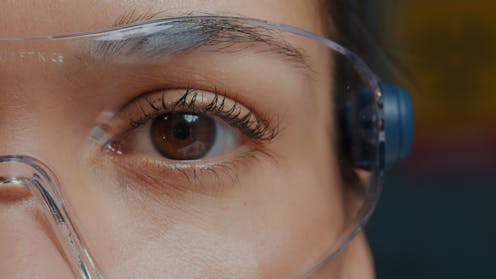Australia’s key program for gender equity in STEM was scrapped last week. This could actually be good news
- Written by Maria Vieira, Lecturer, University of South Australia

Last week, Science and Industry Minister Ed Husic announced[1] with little fanfare that the position of Australia’s Women in STEM Ambassador[2] would be discontinued, effective three days later.
The role was created in October 2018[3] “to encourage girls and women to study and work in science, technology, engineering and mathematics (STEM) fields”. Astrophysicist Lisa Harvey-Smith[4] held the job for its entire existence.
Was the ambassador a success? It’s hard to quantify exactly, but Department of Industry figures[5] show the number of women in STEM-qualified occupations increased by 38% during the ambassador’s tenure, compared with a 10% rise for men. University enrolments for women in STEM courses also grew by 18%, compared with a 9% increase for men.
So does that mean the end of the ambassador position is a setback for gender equity in Australia? Well, not necessarily.
Reasons for discontinuing
The decision came a few months after the publication of a major independent report on diversity in STEM[6] commissioned by the Department of Industry, Science and Resources.
The report indicates more effort is needed to remove cultural and systemic barriers that hinder individuals from diverse backgrounds from entering and sustaining careers in STEM. It also calls for specific changes to the government’s Women in STEM programs, including that “the current Women in STEM Ambassador program should not be extended”.
So the government’s decision is based on considered, independent advice.
What was the reason for this advice? Over the past decade, Australia has had hundreds of disconnected STEM activities that have not been very effective in addressing gender equity issues.
Although the statistics shared by the ambassador appear promising at first glance, a deeper analysis reveals a less encouraging reality. For instance, the most recent data shows that, between 2021 and 2022, the number of women in STEM-qualified occupations only increased by the same percentage as men (4%)[7].
Also, even though university enrolments for women in STEM courses have increased, this growth is not reflected in completion rates. For example, only 15% of women who had completed their studies by 2016 graduated in STEM fields, compared to 33% of men[8], indicating issues with retaining women in these courses.
Additionally, this statistic does not account for the significant disparities between different STEM fields. While women make up over half of the student enrolments and completions in fields such as agriculture, natural and environmental sciences, they remain significantly underrepresented[9] in engineering (18% of completions) and technology (23% of completions). These initiatives lacked a strong research background and effective evaluation, failing to analyse each STEM field with its unique characteristics.
The report found “a need for a centralised approach to drive ambitious progress on diversity in STEM across all sectors”.
What it means for the future of equity
If this decision is any guide, the government is likely to implement more of the report’s suggested changes. So what can we anticipate?
One expected change is a broader perspective on equity in STEM. We are likely to see more attention to other kinds of diversity beyond gender, and also recognition of non-binary approaches to gender. This approach may address equity more systematically. Including intersectional factors such as disabilities, race, Indigenous status and socioeconomic background may benefit more disadvantaged communities.
Additionally, equity programs may have a stronger basis in evidence and long-term orientation. The report emphasises the importance of greater coordination across programs to avoid duplication, lack of connection, and missed opportunities.
While the overall approach may have more centralised coordination, the functions now carried out by the ambassador are likely to be split up among multiple people from diverse backgrounds. This would place less weight on a single individual and also broaden the scope of the program’s advice, which is again a positive change.
Monitoring and evaluation too should receive more attention, becoming more focused with clear indicators of success or failure.
We can also expect more reporting of what has been learned from past programs, so that funders and organisations can make future efforts more effective.
Potential drawbacks
While the changes proposed in the report are positive overall, they could also have drawbacks.
One example is the risk that national centralisation may make states and regions less able to address their own specific needs. In primary and secondary education, for instance, each state operates independently, which might affect the effectiveness of national initiatives.
Another concern is that a long-term orientation and more stringent requirements for data and record-keeping may make for more bureaucracy. This could be time-consuming and affect innovation.
The report also calls for other action to promote diversity via migration, education, grant allocation and workplace changes. However, not everything can be a high priority.
The success of efforts to increased diversity in STEM will depend on the government’s ability to demonstrate a strong commitment and maintain transparency. This involves setting clear priorities and focusing on key areas that can create the most significant impact.
References
- ^ announced (www.minister.industry.gov.au)
- ^ Women in STEM Ambassador (www.unsw.edu.au)
- ^ created in October 2018 (www.minister.industry.gov.au)
- ^ Lisa Harvey-Smith (lisaharveysmith.com)
- ^ Department of Industry figures (www.industry.gov.au)
- ^ major independent report on diversity in STEM (www.industry.gov.au)
- ^ only increased by the same percentage as men (4%) (www.industry.gov.au)
- ^ compared to 33% of men (www.industry.gov.au)
- ^ significantly underrepresented (www.industry.gov.au)














